Sol Luckman
“No real reality could produce 18 gajillion competing versions of string theory.” —Yours Truly
In an observer-based universe like the one we apparently inhabit, “science” itself, as I’ve argued for some time now, is likely an illusion, leaving the very possibility of external knowledge (as opposed to internal gnosis) open to debate.
In coming to terms with the problem of the so-called scientific method, we could easily get lost down the rabbit hole of philosophical skepticism, and yet this school of thought is also potentially an extremely empowering—even unifying—vantage from which to view “reality.” From Wikipedia:
Philosophical skepticism is a doubtful attitude toward commonly accepted knowledge claims. It is an important form of skepticism. Skepticism in general is a questioning attitude toward all kinds of knowledge claims. In this wide sense, it is quite common in everyday life: many people are ordinary skeptics about parapsychology or about astrology because they doubt the claims made by proponents of these fields. But the same people are not skeptical about other knowledge claims like the ones found in regular school books. Philosophical skepticism differs from ordinary skepticism in that it even rejects knowledge claims that belong to basic common sense and seem to be very certain. For this reason, it is sometimes referred to as radical doubt.
We have, for example, among today’s “truthers” an individual claiming that his calendrical information is superior to newer information (such as that found online) simply because it comes from “old books.”
What exactly defines “old” seems to change depending on this individual’s mood; nor is the arbitrariness of the moving line of his delineation ever examined in good faith.
Whether this “old” information is itself problematic, or has perhaps even been “Mandela Effected” and actually changed (as many family bibles have reportedly been), is never likewise allowed to be seriously debated in this person’s “truther” “community” chock-full of blind believers willing to defend their leader to the death without so much as an independent thought of their own. (Recall that cults are designed to control the mind, or govern-ment.)
Philosophical skepticism allows us to easily see through the logical fallacy of this particular doomsayer’s position, but it also works in other areas.
Starting during the pandemic, plandemic, scamdemic or whatever you wish to call the nightmare that overtook this “reality” beginning in late 2019, it was easy enough to grasp that, on one level, those of us questioning the existence of viruses were engaged in a variety of philosophical skepticism.
But the rabbit hole didn’t stop here. Although there’s some disagreement on this subject, it’s often remarked by educated (whatever that means these days) people that you can’t prove a negative. So to say that viruses per se don’t exist is—philosophically anyway—already on shaky ground.
Beyond this somewhat sophomoric criticism, however, lay a deeper problem: that of the very existence of knowledge itself.
If we can’t know anything here, wherever this is, it doesn’t matter whether we’re affirming a positive (the “virus” narrative) or attempting to prove a negative (the “no virus” counternarrative).
In this illusory realm in which matter itself appears to disappear despite our best attempts to pin it down in the microcosm, NOTHING is ultimately verifiable—even if, in this age dominated by the cult religion of “science” (which resembles a hypnotic séance more than anything rational) we flatter ourselves that it is.
As Florinda Donner writes in BEING-IN-DREAMING about the “place of reason” occupied by today’s society in a section worth quoting at length:
[W]hether we are scholars or laymen, we are nonetheless members and inheritors of our Western intellectual tradition. And that means that regardless of our level of education and sophistication, we are captives of that intellectual tradition and the way it interprets what reality is.
Only superficially ... are we willing to accept that what we call reality is a culturally determined construct.
And what we need is to accept at the deepest level possible that culture is the product of a long, cooperative, highly selective, highly developed, and last but not least, highly coercive process that culminates in an agreement that shields us from other possibilities.
[Shamans] actively strive to unmask the fact that reality is dictated and upheld by our reason; that ideas and thoughts stemming from reason become regimes of knowledge that ordain how we see and act in the world; and that incredible pressure is put on all of us to make certain ideologies acceptable to ourselves [...]
What is culturally determined is that our personal experiences, plus a shared social agreement on what our senses are capable of perceiving, dictate what we perceive.
Take, for example, the cause of bubonic plague, which has been “culturally determined” by “reason” to be one thing and one thing only. Germ theorists smugly know that the bubonic plague was an infectious bacterial disease caused by fleas.
Terrain theorists, on the other hand, offering an alternative explanation, “reasonably” counter that we know no such thing, since various types of potentially disease-causing pollution in the medieval world would make today’s China look as pristine as Greenland.
And yet, throwing a wrench in both of these “reasonable” explanations, it has been documented that putrefied body parts literally rained down from the sky in various hard-hit locations just before the Black Death ballooned into a tremendous tragedy.
So what really happened? And how could anybody really know?
Obviously, only cultists—of one stripe or another—think they can and do know for sure.
Seeing Eye to Eye
One issue that has always concerned me in the great Viral Debate (to cite one example of a myriad of parallel ones) is how two groups of ostensibly intelligent people can arrive at such diametrically opposed viewpoints as to utterly disparage each other’s perspectives ... based on “science.”
Having interviewed so many in the “no virus” camp during the COVID era, I’m convinced that—to a person—they’re absolutely genuine in their contrarian assessment of the data showing that pathogenic viruses are a myth of scientism.
Most of these researchers are, in my opinion, compassionate and honorable in their heartfelt desire to get at the truth for the betterment of humanity.
On the other side of the testy conflict surrounding the proof (or lack thereof) of infectious viruses, we have figures such as Dr. Joseph Mercola, Del Bigtree, Steve Kirsch, and Jeremy Hammond.
For the longest time, like a good little terrain theorist, I considered the majority of such folks who justifiably decry the covax but inexplicably swallow virology whole deluded at best, sellouts at worst, and in some cases jerks to boot.
And like a good little conspiracy theorist, I was perfectly willing to entertain the possibility that such “researchers” might actually be actors playing their slimy bit parts in an elaborate psyop emerging from the bowels of the Deep State to enslave us all.
But what if there’s another explanation? What if they simply really believe that contagious viruses exist and cause disease?
And what if, in a manner that could only happen in either a wholly quantum (read: magical) universe or a completely simulated dreamscape, in a way they’re right?
What if both sides are right? What if our divine default mode of seeing what we believe (as opposed to believing what we see) makes the old Newtonian grammar of either/or obsolete?
What if, instead, because we’re all just making shit up anyway, if we’re ever to see eye to eye when it comes to “science” or anything else, we need to start talking in terms of both/and?
And what if this is a way out of groupthink and cultspeak into a remarkably brighter and freer day?
Egregores, Tulpas & Mental Viruses
Some time ago I was being interviewed by “bad boy” Chef Pete Evans from Down Under, when our conversation veered into exactly this kind of extreme-relativity territory in which subjective consciousness reigns supreme.
As someone sitting on the fence of the virology debate, he asked me, a hardcore “no viruser” cultist at the time, whether (I’m paraphrasing from memory) there was any chance something like a “mental virus” might actually be involved in “COVID.”
Specifically, he wondered if we might be looking at something like an egregore, defined by Wikipedia as an ...
occult concept representing a non-physical entity that arises from the collective thoughts of a distinct group of people. Historically, the concept referred to angelic beings [...] In more recent times, the concept has referred to a psychic manifestation, or a thoughtform, which occurs when any group shares a common motivation—being made up of, and influencing, the thoughts of the group.
Years previously, I’d republished an article titled “Are We Living in a Virtual Simulation” by the legendary Jon Rappoport on the simulation hypothesis in which he described a similar phenomenon:
The ancient Tibetans ... were daring adventurers on the edge of experiments in consciousness.
Relying on the teachings of itinerant outcast adepts from India, they developed a practice called, by a few later scholars, “deity visualization.” (See John Blofeld, THE TANTRIC MYSTICISM OF TIBET.)
Perhaps based on an already existing mandala-painting, a teacher would give his student a very detailed and specific “personage” to create in his imagination. This effort, if it was successful at all, might take months or even years.
The objective was to mentally hold the complex image intact, in every detail, not just for a few seconds or minutes, but indefinitely. If the student was successful at this arduous task, he would soon find that the personage he created seemed to take on a life of its own.
The personage or deity would become the student’s friend and guide and give him valuable advice and counsel. When the teacher sensed this relationship had progressed to a very close point, he would order the student to get rid of the personage altogether.
This, it was said, was more difficult than the original act of creating it. But if the student was able to perform both aspects (creative and destructive) of the exercise, he would then realize, see, and know, with full consciousness, that THE UNIVERSE WAS A PRODUCT OF MIND.
At that crossroad, he would be able to spontaneously take apart pieces of “the hologram” or “the lattice,” and even create (out of nothing) new objects that hadn’t existed before.
Moreover, I’d recently published my novel CALI THE DESTROYER, which features a major theme involving a related concept called a tulpa, defined by spiritualist Alexandra David-Néel, according to Wikipedia, as a term for “magic formations generated by a powerful concentration of thought.”
But even though I’d done my homework in this controversial area on the fringes of consensus reality and was inclined to entertain the possibility of such extraordinary paranormal entities, I responded in the negative to Pete’s inquiry about a theoretical mental virus in almost as knee-jerk a fashion as any bona fide terrain cultist would.
Now, to be clear, many in the “no virus” cult freely admit the potential for something akin to a nocebo effect where “SARS-CoV-2” and other alleged pathogens are concerned. Fearmongering lathered on 24/7 by an agenda-driven press for years would almost have to produce significant psychosomatic effects in the populace.
But this wasn’t what Pete and I were discussing. We were questioning whether a new thoughtform called “SARS-CoV-2” had been introduced into human consciousness, which had then made an imaginary virus effectively real on a mass scale.
In retrospect, my visceral refusal to explore this radical possibility—despite my deep knowledge of such mystical terrain—should have been a red flag that I’d been forced into an either/or way of seeing in a both/and world dominated by the divide-and-conquer dynamics common to cult thinking.
Two Sides of the Same Coin
My view is that what passes for reality in this deeply fractured construct is purposely engineered not via a controlled opposition (singular) but by controlled oppositions (plural) pitting an abundance of seemingly logically justified worldviews against each other.
Without going terribly far down yet another rabbit hole (an even deeper one) just yet, we might entertain how a type of etheric parasitic force—call it the Great Parasite— could have “infected” the dreamscape of this “reality” and now seeks to subjugate humanity, which it can only do, in a digitized or otherwise “unreal” world based in human minds, by controlling human minds, duh.
“Worldview” is a key word in this discussion, as it reminds us that each side of any debate or conflict—including the one about alleged viruses or the more recent one over the existence or nonexistence of our very DNA—is creating the world it sees.
Specifically, the simulated dreamscape of “reality” feeds to each side data and “facts” that support each side’s beliefs. This literally means that “virus” pushers may actually be seeing and evaluating different evidence from that presented by the simulated dreamscape to team “no virus.”
I realize this may sound preposterous, and it would be in a real-world situation. But I contend that’s not what’s going on here.
Instead, we’re talking about a massively sensitive and complex metaverse in which—if I might be permitted to process one of the most famous stories from ancient history through a simplified simulationist lens—an entire advanced civilization trying to hack its way out of here was sent packing to the four winds, no longer even able to understand one another, at the stroke of a keyboard.
This iconic episode from the (invented) history of the simulacrum is called ... the Tower of Babel. I propose that we find ourselves today in an eminently Babelesque scenario in the Great Viral Debate.
Technically, there’s no “wrong” in such a confounding situation; everyone’s right ... in their simulated version of the world.
And because they’re absolutely right and they can “prove” it, at least to themselves, they’re absolutely convinced (with good reason) that the other side is wrong.
A helpful concept for understanding how this dynamic might play out in a magical world or simulated dreamscape comes from Itzhak Bentov, Paul LaViolette, Rupert Sheldrake and others theorizing how individual and collective information (or “morphic”) fields might interact to create distinctive—and often contradictory— experiences of “reality.”
Basically, as I see them, morphic fields are bubbles of consciousness, or arrangements of conscious bioenergy (auras or auric fields), that interact to create interference patterns with the world’s magical, simulated or dreamlike substrate, which then feeds back to us ... exactly what we put into it.
In the case of virology, one side has used the massive morphic field of germ theory in the egregoric creation of its “virus.”
Up against this Rockefeller-financed wrecking ball for health and sovereignty, the terrain camp has played the role of underdog in seeking to create a strong enough morphic field for its egregoric “nonexistent virus” to “upset” the dominant narrative.
Certainly, the latter viewpoint—which is basically just a choice—is a lot more empowering for humanity, but that’s off the subject.
Everyone playing a role in this divine comedy seems to have forgotten that, as with Gertrude Stein’s hometown of Kansas City, either way you go, in the end there’s no there there.
No version of science is “broken” because the “scientific” method, in its purest sense, is a materialistic myth in an immaterial setting.
The only thing real here is our consciousness— specifically, our innate ability to use our imaginative and dreaming capacities to create what feels like a real world full of real experiences.
Seeing what they believe and not what is, neither side sees that this is all just a BIG GAME in which both sides are merely propping each other up in a false dichotomy that keeps the Matrix very much in control of the field of play through the oldest diversionary technique in the world’s oc(cult) history: separate and annihilate.
It’s fascinating to note that even certain key figures in the “no virus” camp with pronounced metaphysical leanings are actually acting more like closet materialists in their focus on lack of physical “proof” of ... whatever. As if any of that actually meant anything.
Me, I used to think that if people could just wake up to the unreality of viruses, the world would change—and it might, a little.
But compare this to a mass awakening to the unreality of reality. Then the world wouldn’t just change. The dreamscape would transform. And then, no doubt about it, we’d be free.
Copyright © Sol Luckman. All Rights Reserved.
👉 Inspired by this post?
🙏 Donate bitcoins: 14ptJHFnNTxRnm757CxAWFtXfggy8BpwHG
👀 DISCLAIMER: Trolls banned immediately. No medical claims made. Opinions expressed here are just that. Growing up is your responsibility.








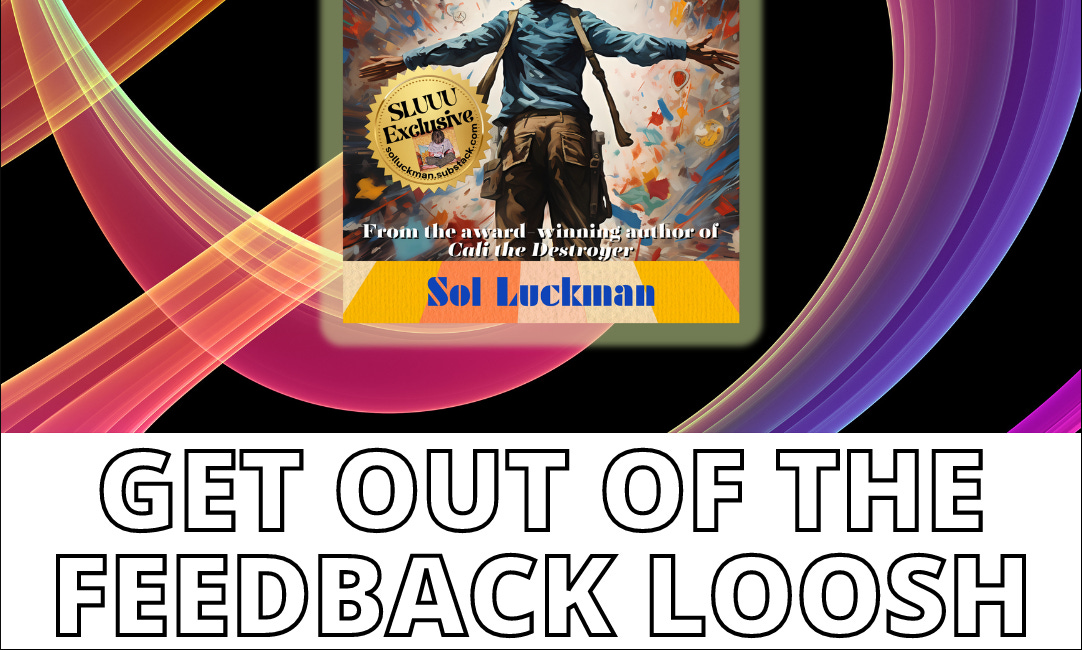


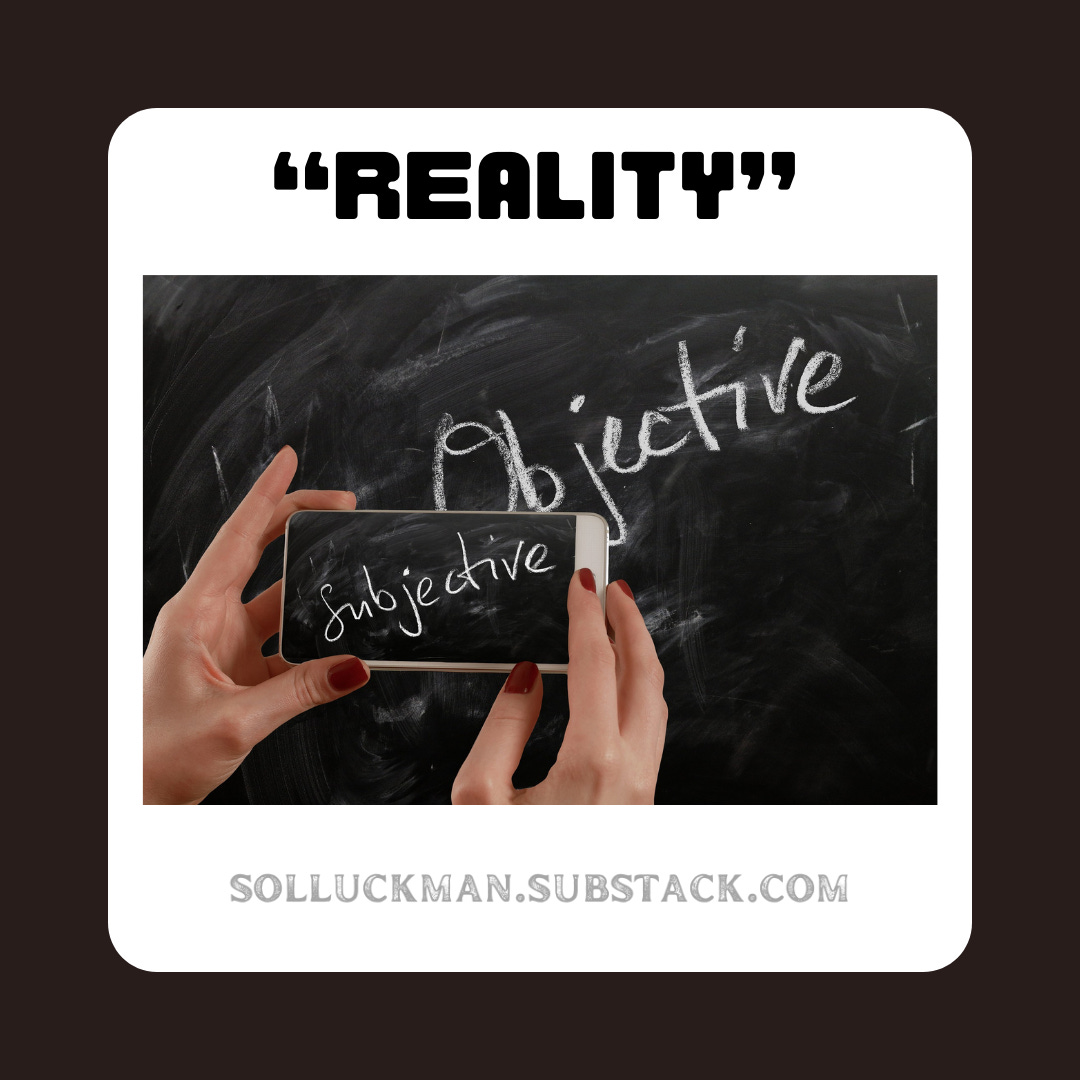


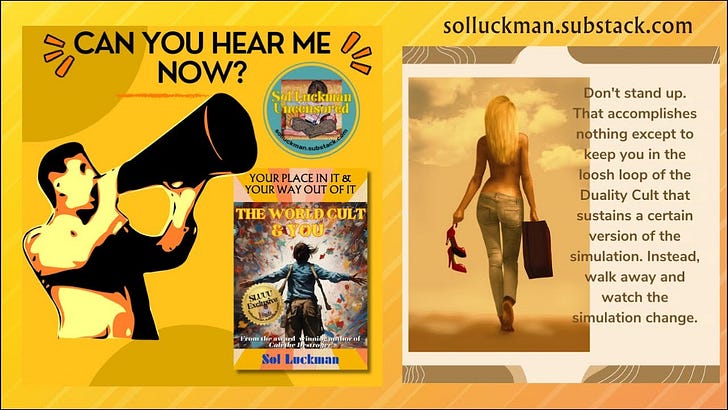


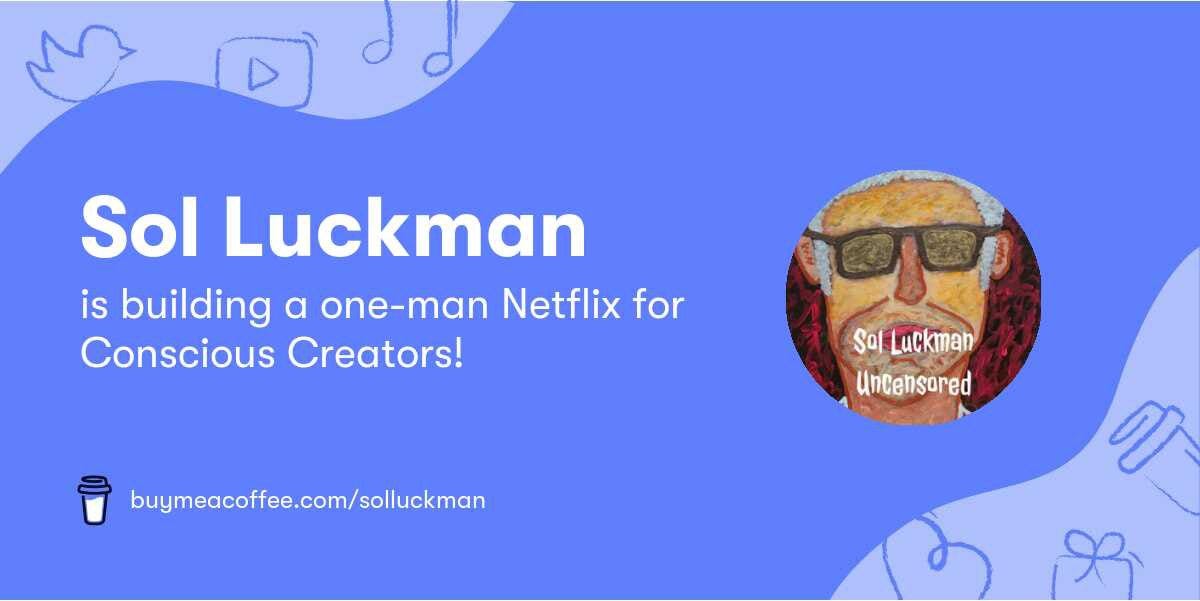
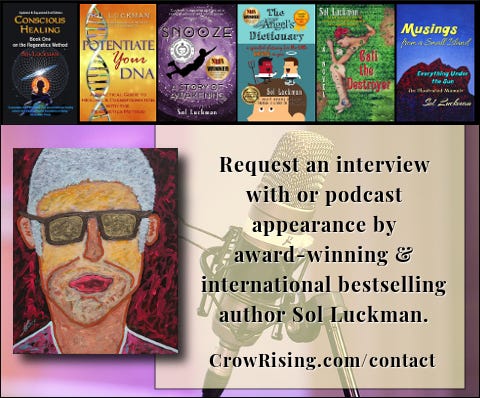

🤯 How to WIN the Guerilla War against the World CULT https://www.youtube.com/watch?v=qUNHV3Lq-E4&ab_channel=SolLuckmanUncensored
🤯 How to Navigate “Reality” without Becoming Shipwrecked on the Desert Island of a CULT https://solluckman.substack.com/p/how-to-navigate-reality-without-becoming-88d We can leave the false dichotomy of “fact” and “fiction” behind as we embrace our identity as Consciousness Artists imaginatively building the “realities” we observe.